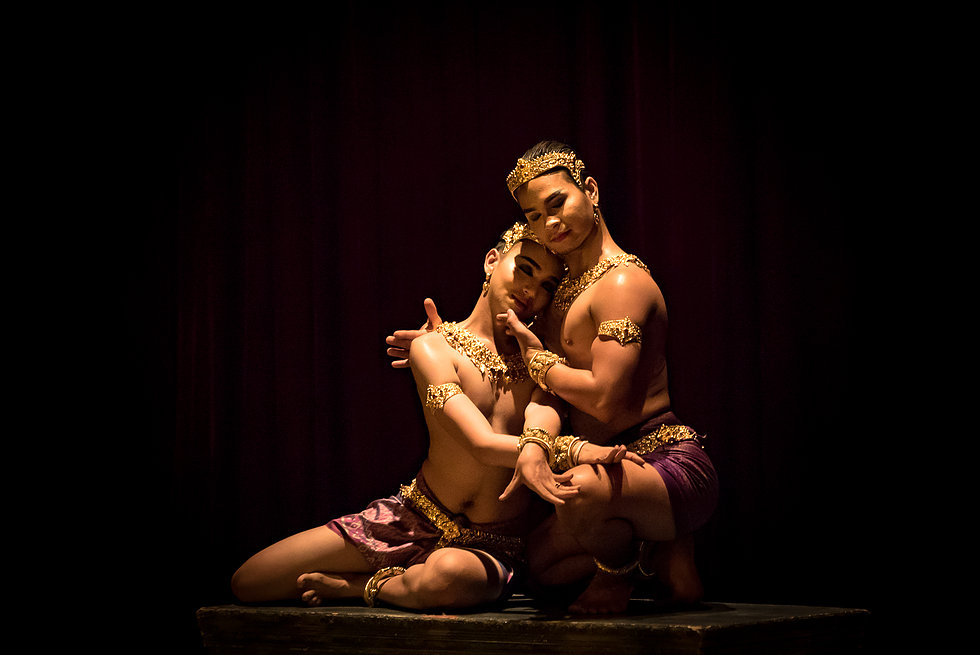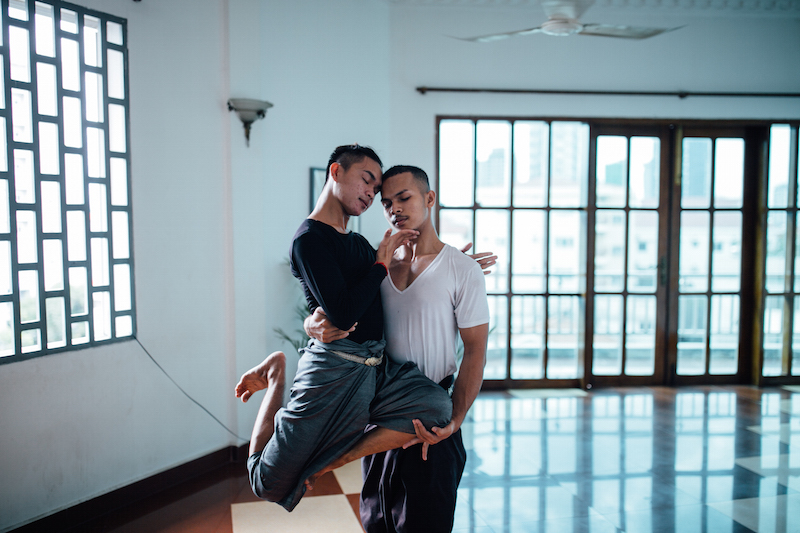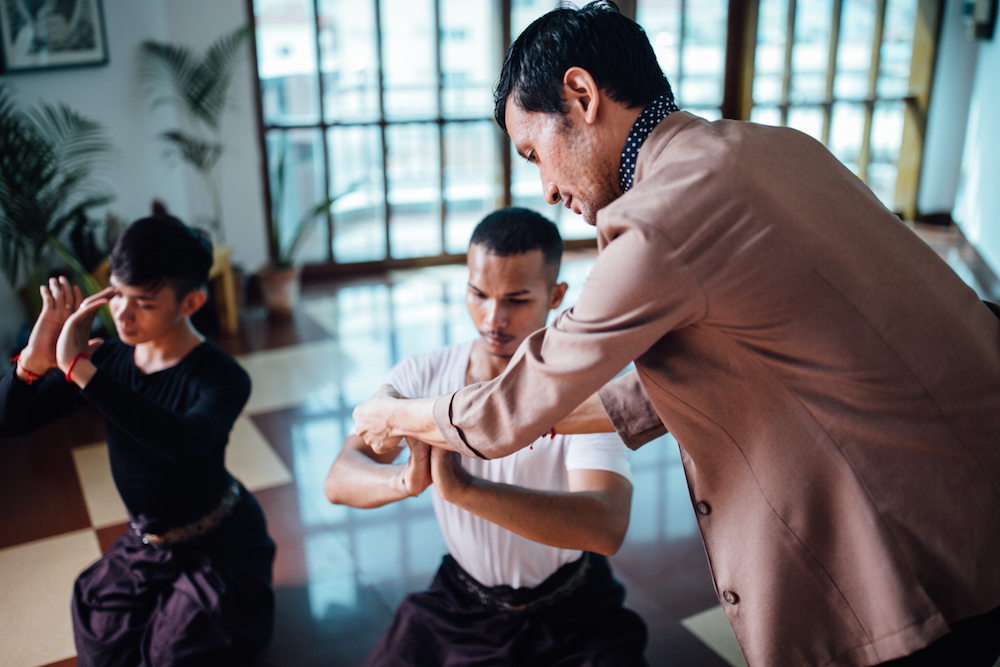
Dancing Against Discrimination
Cambodia’s first gay dance company is using classical Khmer dance to break down cultural barriers and challenge society’s preconceptions.
By Julia-Grace Sanders
August, 11 2017
Five floors above the rush of cars and motorbikes on Phnom Penh’s Sihanouk Boulevard, six young dancers glide across the polished living room floor of Prumsodun Ok’s apartment. They’re performing classical Khmer dance, executing the elaborate moves with a beauty and elegance much like traditional Cambodian dancers have for centuries.
But with Sam Smith’s “Lay Me Down” floating through the air and men filling the roles typically played by women, the scene is far from conventional.
The dancers are part of Prumsodun Ok & Natyarasa, Cambodia’s first gay dance company, which is redefining the boundaries of the ancient art form and using it to change societal perceptions of the LGBTQ communuty.
“What we’re doing, what’s new about it, is that we’re using the dance as a tool to elevate society to make the community and Cambodia and the world a more inclusive and compassionate space,” says Mr. Ok, the company’s 30-year-old founder and director.
Their interpretation of the dance, giving a Khmer classic a modern twist, has divided opinions. They have won over audiences for their shows, with one leading scholar on Khmer dance, Toni Shapiro-Phim, describing their performances as “exquisite.” Detractors, however, claim their provocative acts—such as their performance of “Robam Santhyea Vehea,” which depicts the love and marriage of two male gods—are an affront, destroying Cambodian culture by allowing gay men to perform such roles.
—
As the dancers rehearse, they sweep their hands, bent at an angle that takes years to perfect, to new positions at a pace that makes the room feel as if time has slowed. Every movement freezes briefly as if an art piece in itself before gliding onward with painstaking precision. Despite their glacial rhythm, the dancers’ toned chests heave under sweaty T-shirts.

Mr. Ok gazes intently at their forms, moving from dancer to dancer, pushing a foot a few centimeters to the right or hands a smidge closer together to accomplish the technical exactness that defines classical Khmer dance.
He wants his dances to have a dual purpose—to preserve the tradition of classical Khmer dance and to transform it into something that more accurately reflects the diversity of Cambodian society.
“There’s this hunger that young people in Cambodia have for things that are new,” Mr. Ok says. “They want to see their traditions reflect who they are. If you look into a piece of art and you don’t see yourself, chances are you won’t feel connected or have a sense of love for that thing.”
Seen live, the shows are well-received, Mr. Ok says. Faultfinders use Facebook to let them know.
“Some people say they are OK with us being gay, but they don’t understand why we have to dance classical dance,” says Chamroeun Dara, one of Mr. Ok’s students. “And some people are completely unaccepting of our sexuality.”
Mr. Ok sees the comments as a sign they’re succeeding. “Sometimes you have to shake someone’s reality a little bit in order for them to wake up, grow and see a bigger picture,” he says.
At first, Mr. Dara says the comments really hurt him. He eventually came to realize they only represented the opinions of a few people. However, he still faces pressure from his family and friends, who feel the negative feedback reflects poorly on them.
“There’s this misperception that tradition is static or that it’s rigid,” Mr. Ok says. “It’s a perception that many people carry when they’re removed from the actual tradition. People on the inside know people are always innovating, looking for ways to be more beautiful and more meaningful.”

Mr. Dara, 21, says he’s seen classical dance diminish during his generation, and it’s his dream to help save it by becoming a professional classical dancer and teacher. “Some people say ‘I love my culture, I don’t want to see it go’ but they’re doing nothing to save it,” he says. “It has to be spread to the next generation by me, not just by the woman. I can help it to go on, and I’m scared of losing it.”
For him, classical dance is more than just a performance—it’s a spiritual experience. “Classical dance is the bridge across from the world to the gods,” he says. “I love classical dance because it makes me feel higher when I’m performing. It’s a higher form, a sacred dance.”
Mr. Ok takes stylistic risks with his dances, such as choreographing to new music or creating new patterns of bodies on the stage, but does so with knowledge of, and reverence to, the tradition.
For Ms. Shapiro-Phim, the scholar, the resistance to the modernization of traditional dance may be an aftereffect of the Khmer Rouge.
“The passing down of classical Khmer dance is kinesthetic as well as intellectual and emotional,” she says. “Arguments against innovation are touched with cultural loss from the Khmer Rouge through people who carried actual cultural knowledge in their bodies.”
But dance, as a medium, is always changing, she says. “With that kind of change comes exciting dynamism that resonates with society.”
—

Growing up in Long Beach, California, after his parents fled the Khmer Rouge, classical Khmer dance helped Mr. Ok find his own identity.
“For a long time I pushed myself away from dance because I couldn’t find a teacher and it was a marker of my femininity,” he says. “I was really ashamed and felt the need to protect myself.”
It was only when he attended film school and began to feel more open about himself, he says, that his family embraced his sexuality and became “nothing but loving and supportive.”
They took longer to come to terms with his pursuit of a career in dance.
“When they realized that I was getting very serious about dance, they got scared because being a dancer or being an artist is not a lucrative profession,” Mr. Ok says.
In fact, his parents did everything they could to stop him from dancing and his mom threatened to disown him. When his brother got tired of hearing Mr. Ok argue with his mom about dance, he would beat him up.
“I really had to fight, I had to tear myself away from my family in order to pursue my life and dreams,” Mr. Ok says.
Even today, they don’t really quite know or understand what he’s doing, but “they are happy to see me happy and there is a quiet sense of pride as well,” he says. “My late father once said, ‘When Prum was young, I wanted him to be a doctor, a teacher, or a lawyer. And now, as an artist, I realize that he is all of those things and more.’”
After years of watching his sisters practice their Khmer classical dancing under their teacher, Sophiline Cheam Shapiro, Mr. Ok gathered the courage at 16 to ask if he could practice with her as well. Even then, it wasn’t until he attended film school that he realized the power of dance to elicit social change. “It dawned on me that if I can use film to transform the world, why can’t I use dance?”
In 2015, he came to Cambodia on a fellowship for a single project. After a month of rehearsal, Mr. Ok realized he’d created something bigger. “I looked at the dancers and I was like ‘Whoa, we look like a real company. Whoa, Cambodia’s first gay dance company was just formed in my living room.’”
—

Mr. Ok’s students show up at his apartment, which doubles as a dance studio, at 1 o’clock sharp. Most have already had a long day at college or work, earning a living from jobs like dressing other dancers or performing for music videos.
But every afternoon they dutifully scale five flights of winding stairs to Mr. Ok’s home and rehearse for three to five hours, five days a week. The studio is more than a place to practice: it’s a space where they’ve fostered a community of support and progress.
“It’s meant a lot to me because it makes me brave enough to share about my identity,” Mr. Dara says. “Before I joined, I felt like I was in a cage. Here, I am brave enough to talk about LGBT rights and stand up to the problems that face the LGBT community.”
Mr. Dara says he’s faced insults and bullying for his sexuality, and he’s seen other gay men suffer discrimination at work because they don’t fit society’s idea of what it means to be a man.
For some students, the studio is a place to get the support they lack at home. Mr. Dara’s family supports him as a dancer but remains silent when it comes to his sexuality, while student Dy Puthik, 18, says his family doesn’t support his dance or sexuality.
Their teacher believes that in order to nurture an artist, he must nurture the entirety of the person. “In order for them to be the best dancers and artists, they have to have an awareness of who they are and where they come from to have a clear vision of what they want and where they want to go in the future,” Mr. Ok says.
By nature, Khmer classical dance can be hierarchical, with dominant positions on the stage taking the forefront while others have more of a background role. But Mr. Ok opts for a “culture of democracy” by giving each of his students a chance to shine in the spotlight.
“I’m cultivating a dialogue of respect and dignity and showing them what it means to care for each other, to support each other and be happy for each other’s success,” he says.
The company has so far performed in Siem Reap, Phnom Penh and Bangkok.
“After we perform, some cry and some come up to say they want us to keep doing what we are doing,” Mr. Puthik says. “And that makes the negative comments go away.”
It’s reactions like these that let the dancers know they’re making a difference.
“It’s not just about the dance,” Mr. Puthik says. “It’s also to teach people about why we dance. We want to show them that we are gay, and we want to change the world. We want to show that being gay is not constraining of tradition.”
Instigating social change through classical Khmer dance is not a new concept, says Ms. Cheam Shapiro, the woman who first trained Mr. Ok as a dancer and is now based in Cambodia.
She trained at the Royal University of Fine Arts in Phnom Penh in the 1980s as part of the first generation to do so after the Khmer Rouge.
Over the last 10 to 15 years, classical dance has begun to address social issues, Ms. Cheam Shapiro says. Her own work has dealt with corruption, cultural identity after the Khmer Rouge, divorce, trauma and the cycle of abuse.
“Ok is the first to tackle LGBTQ issues,” Ms. Cheam Shapiro says. “His work is focusing on love, intimacy and the relationship of same-sex couples. He wants to legitimize same-sex love. I think that is a very noble attempt.”
Srun Srorn, a prominent Cambodian LGBTQ activist and founder of anti-discrimination NGO CamASEAN Youth’s Future, says the arts are a very effective tool for social change. “Art is the most important part of the social movement,” he says. “Art is a soft and gentle advocacy tool. It changes people’s minds slowly but effectively.”
Mr. Ok says his company has had a trickle-down effect on people’s perceptions. “Their peers and family are changing their perceptions about who these young men are and what it means to be gay in Cambodia and the broader world today,” he says.
“And that eventually affects the broader community.”
He never intended to move to Cambodia, but has found purpose in his company’s vision to change the world for gay people through a dance he loves.
“To me, the tradition of Khmer classical dance is a very beautiful heritage that I have received. It’s a fight that I carry and I’m charged with the responsibility of taking care of it,” he says.
“I also have the responsibility to use it. To make it my own. If you live your life doing what everyone else does, what is the point of living?”



